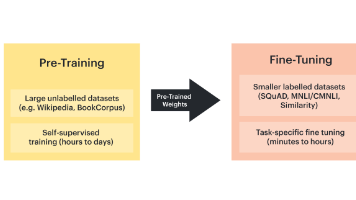服务器部署LLaMAFactory进行LoRA微调
仓库已经成功克隆下来了。Factory支持的格式。LLaMA-Factory支持多种格式,对于文本分类任务,我们可以使用alpaca格式。包含了所有可用的数据集。使用刚刚自定义三个数据采集数据集,需要在文件中添加数据集描述,并通过修改配置来使用数据集。现在让我们添加我们的三个自定义数据集。数据已经成功转换并保存到了正确的位置。接下来可以开始使用这些数据进行训练了。
一、什么是LLaMAFactory
LlamaFactory 是一个专为 大型语言模型(LLM)微调 设计的开源工具库,旨在简化大模型(如 LLaMA、GPT、Mistral 等)的定制化训练流程,降低技术门槛和硬件成本。以下是它的核心功能和应用场景:
1. 核心功能
① 高效微调技术
-
参数高效微调(PEFT)
支持 LoRA、QLoRA、Adapter 等方法,仅训练少量参数(如原模型的0.1%),显存需求降低50%-80%。-
示例:在24GB显存的RTX 4090上微调7B模型(默认全参数微调需80GB+显存)。
-
-
量化训练
支持4/8-bit量化(结合bitsandbytes),进一步压缩显存占用。 -
梯度检查点
通过牺牲计算时间换取显存,支持更长上下文训练。
② 多模型与多任务支持
-
兼容主流架构:LLaMA、Baichuan、ChatGLM、Qwen、GPT、Mistral等。
-
多任务适配:支持指令微调(Instruction Tuning)、领域适配(如医疗、法律)、对话模型优化等。
③ 分布式训练优化
-
支持多卡并行(数据并行、模型并行)、DeepSpeed ZeRO 加速,适合大模型训练。
④ 用户友好设计
-
可视化Web UI:无需编码即可配置超参数、启动训练。
-
CLI工具:一行命令启动微调,支持自定义数据集格式。
二、部署LLaMAFactroy
首先,让我们尝试使用github的方式克隆仓库:
git config --global http.sslVerify false && git clone --depth 1 https://github.com/hiyouga/LLaMA-Factory.git
# 创建新环境,指定 Python 版本(以 3.10 为例)
conda create -n llamafactory python=3.10 -y
# 激活环境
conda activate llamafactory仓库已经成功克隆下来了。现在让我们进入项目目录并查看一下环境要求:
cd LLaMA-Factory && cat requirements.txt
接下来让我们先检查一下 Python 环境:
python3 --version && pip3 --version
现在让我们安装所需的依赖:
pip3 install -r requirements.txt要启动Web UI,可以运行:
cd LLaMA-Factory && python3 src/web_demo.py新建原始数据json文件夹

Factory支持的格式。LLaMA-Factory支持多种格式,对于文本分类任务,我们可以使用alpaca格式。创建一个转换脚本:
import pandas as pd
import json
from pathlib import Path
def convert_tnews(input_file):
df = pd.read_csv(input_file, sep='\t', header=None, names=['id', 'text', 'label'])
# 更新后的标签映射
label_map = {
'100': '民生',
'101': '文化',
'102': '娱乐',
'103': '体育',
'104': '财经',
'106': '房产',
'107': '教育',
'108': '科技',
'109': '军事',
'110': '旅游',
'112': '国际',
'113': '证券',
'114': '农业',
'115': '政务',
'116': '电商'
}
conversations = []
for _, row in df.iterrows():
label = str(row['label'])
if label in label_map:
category = label_map[label]
else:
continue
item = {
"instruction": "请判断以下新闻属于哪个类别。",
"input": row['text'],
"output": category
}
conversations.append(item)
return conversations
def convert_ocemotion(input_file):
df = pd.read_csv(input_file, sep='\t', header=None, names=['id', 'text', 'label'])
# 更新后的标签映射
label_map = {
'sadness': '悲伤',
'happiness': '快乐',
'disgust': '厌恶',
'anger': '愤怒',
'like': '喜欢',
'surprise': '惊讶',
'fear': '恐惧'
}
conversations = []
for _, row in df.iterrows():
label = str(row['label']).strip()
if label in label_map:
emotion = label_map[label]
else:
continue
item = {
"instruction": "请判断以下文本表达的情感。",
"input": row['text'],
"output": emotion
}
conversations.append(item)
return conversations
def convert_ocnli(input_file):
df = pd.read_csv(input_file, sep='\t', header=None, names=['id', 'sentence1', 'sentence2', 'label'])
label_map = {
'0': '蕴含',
'1': '矛盾',
'2': '中立'
}
conversations = []
for _, row in df.iterrows():
label = str(row['label'])
if label in label_map:
relation = label_map[label]
else:
continue
item = {
"instruction": "判断两个句子之间的关系。",
"input": f"句子1:{row['sentence1']}\n句子2:{row['sentence2']}",
"output": relation
}
conversations.append(item)
return conversations
def main():
# 修改为正确的路径
data_dir = Path('/root/LLaMA-Factory/tcdata')
output_dir = Path('/root/LLaMA-Factory/data')
output_dir.mkdir(parents=True, exist_ok=True)
# 转换TNEWS数据
print("Converting TNEWS dataset...")
tnews_conversations = convert_tnews(data_dir / 'TNEWS_train1128.csv')
with open(output_dir / 'tnews_train.json', 'w', encoding='utf-8') as f:
json.dump(tnews_conversations, f, ensure_ascii=False, indent=2)
print(f"Converted {len(tnews_conversations)} TNEWS examples")
# 转换OCEMOTION数据
print("\nConverting OCEMOTION dataset...")
emotion_conversations = convert_ocemotion(data_dir / 'OCEMOTION_train1128.csv')
with open(output_dir / 'emotion_train.json', 'w', encoding='utf-8') as f:
json.dump(emotion_conversations, f, ensure_ascii=False, indent=2)
print(f"Converted {len(emotion_conversations)} OCEMOTION examples")
# 转换OCNLI数据
print("\nConverting OCNLI dataset...")
ocnli_conversations = convert_ocnli(data_dir / 'OCNLI_train1128.csv')
with open(output_dir / 'ocnli_train.json', 'w', encoding='utf-8') as f:
json.dump(ocnli_conversations, f, ensure_ascii=False, indent=2)
print(f"Converted {len(ocnli_conversations)} OCNLI examples")
if __name__ == '__main__':
main() dataset_info.json 包含了所有可用的数据集。使用刚刚自定义三个数据采集数据集,需要在 dataset_info.json 文件中添加数据集描述,并通过修改 dataset: 数据集名称 配置来使用数据集。
现在让我们添加我们的三个自定义数据集。修改 dataset_info.json 文件:

"tnews_train": {
"file_name": "tnews_train.json",
"formatting": "alpaca",
"columns": {
"prompt": "instruction",
"query": "input",
"response": "output"
}
},
"emotion_train": {
"file_name": "emotion_train.json",
"formatting": "alpaca",
"columns": {
"prompt": "instruction",
"query": "input",
"response": "output"
}
},
"ocnli_train": {
"file_name": "ocnli_train.json",
"formatting": "alpaca",
"columns": {
"prompt": "instruction",
"query": "input",
"response": "output"
}
}现在我们已经在 dataset_info.json 中添加了三个新的数据集配置:
tnews_train:新闻分类数据集
emotion_train:情感分类数据集
ocnli_train:自然语言推理数据集
数据已经成功转换并保存到了正确的位置。接下来可以开始使用这些数据进行训练了。以下是后续步骤:
1.下载Qwen基础模型:
- 您可以使用Qwen-7B或Qwen-14B作为基础模型
- 模型可以从Hugging Face下载
pip install -U huggingface_hub
创建一个目录来存放模型:
mkdir -p LLaMA-Factory/models/Qwen-7B-Chat && cd LLaMA-Factory/models/Qwen-7B-Chat 
方法一:使用Git LFS克隆Qwen-7B-Chat模型仓库:
cd LLaMA-Factory/models && GIT_LFS_SKIP_SMUDGE=1 git clone https://huggingface.co/Qwen/Qwen-7B-Chat方法二:使用ModelScope镜像来下载模型:
pip install modelscope && cd /root/LLaMA-Factory/models && python3 -c "from modelscope import snapshot_download; snapshot_download('qwen/Qwen-7B-Chat', cache_dir='.')" 
接下来我们将使用LLaMA-Factory进行微调。我们将使用Qwen-7B-Chat作为基础模型,使用我们处理好的三个数据集进行训练。
接下来让我们理解一下,lora微调所涉及到的文件

qwen2vl_lora_dpo.yaml qwen2vl_lora_sft.yaml 这两个文件有什么区别?
这两个文件都是LLaMA-Factory的训练配置文件,但它们有几个重要的区别:
训练阶段(stage)不同:
- qwen2vl_lora_sft.yaml: stage: sft (监督微调,Supervised Fine-Tuning)
- qwen2vl_lora_dpo.yaml: stage: dpo (直接偏好优化,Direct Preference Optimization)
学习率(learning_rate)不同:
- sft: learning_rate: 1.0e-4 (较大的学习率)
- dpo: learning_rate: 5.0e-6 (较小的学习率)
特有参数:
- dpo 特有:
pref_beta: 0.1 # DPO的beta参数
pref_loss: sigmoid # 偏好学习的损失函数类型
数据集配置不同:
- sft: dataset: mllm_demo,identity,alpaca_en_demo (普通的指令数据集)
- dpo: dataset: rlhf_v (包含偏好信息的数据集)
主要区别在于它们的用途:
- sft配置用于第一阶段的监督微调,让模型学习基本的指令跟随能力
- dpo配置用于第二阶段的偏好优化,通过人类偏好数据来改进模型输出的质量
这反映了现代大语言模型训练的两个重要阶段:
- SFT(监督微调):让模型学会基本的任务完成能力
- DPO(偏好优化):让模型的输出更符合人类偏好,提高输出质量
如果是第一次训练模型,建议先使用sft配置进行基础训练,然后再考虑使用dpo配置进行优化。
LoRA 是一种 参数高效微调技术(Parameter-Efficient Fine-Tuning, PEFT),专为大型语言模型(如 LLaMA、GPT)设计,旨在显著减少微调所需的计算资源和显存,同时保持模型性能。
三、 详细讲解 qwen2vl_lora_sft.yaml 这个配置文件的主要部分:
### model(模型配置)
model_name_or_path: Qwen/Qwen2.5-VL-7B-Instruct # 基础模型路径
image_max_pixels: 262144 # 图像最大像素数
video_max_pixels: 16384 # 视频最大像素数
trust_remote_code: true # 信任远程代码
### method(训练方法配置)
stage: sft # 训练阶段:监督微调
do_train: true # 是否进行训练
finetuning_type: lora # 使用LoRA微调方法
lora_rank: 8 # LoRA秩,越大效果越好但参数量也越大
lora_target: all # 应用LoRA的层,all表示所有层
### dataset(数据集配置)
dataset: mllm_demo,identity,alpaca_en_demo # 使用的数据集,可以多个
template: qwen2_vl # 使用的模板
cutoff_len: 2048 # 最大序列长度
max_samples: 1000 # 最大样本数
preprocessing_num_workers: 16 # 数据预处理的工作进程数
### output(输出配置)
output_dir: saves/qwen2_vl-7b/lora/sft # 输出目录
logging_steps: 10 # 每10步记录一次日志
save_steps: 500 # 每500步保存一次模型
plot_loss: true # 绘制损失曲线
overwrite_output_dir: true # 覆盖已存在的输出目录
save_only_model: false # 保存完整检查点
report_to: none # 不使用额外的日志记录工具
### train(训练配置)
per_device_train_batch_size: 1 # 每个设备的批次大小
gradient_accumulation_steps: 8 # 梯度累积步数
learning_rate: 1.0e-4 # 学习率
num_train_epochs: 3.0 # 训练轮数
lr_scheduler_type: cosine # 学习率调度器类型
warmup_ratio: 0.1 # 预热比例
bf16: true # 是否使用bf16精度要快速开始训练,需要主要关注以下几个部分:
模型配置:
- 修改 model_name_or_path 为我们自己的的模型路径
- 例如:model_name_or_path: /root/LLaMA-Factory/models/qwen/Qwen-7B-Chat
数据集配置:
- 修改 dataset 为要使用的数据集
- 例如:dataset: tnews_train,emotion_train,ocnli_train
输出配置:
- 修改 output_dir 为想保存模型的路径
- 例如:output_dir: /root/LLaMA-Factory/outputs/qwen-7b-chat-chinese
训练配置:
- 根据您的GPU显存调整 per_device_train_batch_size 和 gradient_accumulation_steps
查看系统的 GPU 显存信息。在 Linux 系统中,我们可以使用 nvidia-smi 命令来查看:
使用 df -h 查看文件系统的使用情况:nvidia-smidf -h
- 如果显存不足,可以:
- 降低 per_device_train_batch_size
- 增加 gradient_accumulation_steps
- 减小 cutoff_len
接下来创建一个适合您当前训练任务的配置文件chinese_sft.yaml:
### model
model_name_or_path: /root/LLaMA-Factory/models/qwen/Qwen-7B-Chat
trust_remote_code: true
### method
stage: sft
do_train: true
finetuning_type: lora
lora_rank: 8
lora_alpha: 32
lora_dropout: 0.1
lora_target: all
### dataset
dataset: tnews_train,emotion_train,ocnli_train
template: qwen
cutoff_len: 2048
max_samples: 100000
preprocessing_num_workers: 8
dataloader_num_workers: 4
### output
output_dir: /root/LLaMA-Factory/outputs/qwen-7b-chat-chinese
logging_steps: 10
save_steps: 100
plot_loss: true
overwrite_output_dir: true
save_only_model: false
do_eval: true
### train
per_device_train_batch_size: 4
gradient_accumulation_steps: 4
learning_rate: 5.0e-5
num_train_epochs: 3.0
lr_scheduler_type: cosine
warmup_ratio: 0.1
bf16: true
ddp_timeout: 180000000
### eval
val_size: 0.01
per_device_eval_batch_size: 4
eval_steps: 100需要先安装 LLaMA-Factory 包,使用 CLI 命令来启动训练:
cd /root/LLaMA-Factory && pip install -e .cd /root/LLaMA-Factory && llamafactory-cli train examples/train_lora/chinese_sft.yaml四、 配置文件中哪些设置和显存有关?
在训练配置文件中,以下参数会直接影响显存使用量:
批量大小相关:
- per_device_train_batch_size: 每个 GPU 的训练批量大小,越大显存占用越多
- gradient_accumulation_steps: 梯度累积步数,可以用来变相减小批量大小
- per_device_eval_batch_size: 评估时的批量大小
精度相关:
- bf16: 是否使用 BF16 精度
- fp16: 是否使用 FP16 精度
- 这两个参数会影响模型权重和计算的精度,从而影响显存使用
模型相关:
- lora_rank: LoRA 的秩,越大参数量越多,显存占用越大
- max_samples: 最大样本数,影响数据加载时的显存占用
- cutoff_len: 序列最大长度,越长显存占用越大
优化器相关:
- max_grad_norm: 梯度裁剪阈值
- optim: 优化器类型,不同优化器显存占用不同
要减少显存使用,可以:
- 减小 per_device_train_batch_size(比如从 64 改为 16 或 8)
- 增加 gradient_accumulation_steps(比如从 1 改为 4 或 8)
- 减小 lora_rank(比如从 8 改为 4)
- 减小 cutoff_len(如果可以的话)
- 减小 max_samples(如果可以的话)
五、训练过程中如遇到显存不够可做以下调整:

主要更改:
- 增加了 gradient_checkpointing: true 以减少显存使用
- 使用 8-bit 优化器:optim: paged_adamw_8bit
- 增加梯度累积步数:从 8 改为 16
- 添加梯度裁剪:max_grad_norm: 0.5
- 添加 LoRA dropout:lora_dropout: 0.1
即使使用了这些优化方法,显存仍然不够。让我们尝试设置 PYTORCH_CUDA_ALLOC_CONF 环境变量,并进一步优化配置:
### model
model_name_or_path: /root/LLaMA-Factory/models/qwen/Qwen-7B-Chat
image_max_pixels: 262144
video_max_pixels: 16384
trust_remote_code: true
### method
stage: sft
do_train: true
finetuning_type: lora
lora_rank: 4
lora_alpha: 32
lora_target: q_proj,v_proj
lora_dropout: 0.1
### dataset
dataset: ocnli_train,emotion_train,tnews_train
template: alpaca
cutoff_len: 1024
max_samples: 1000
overwrite_cache: true
preprocessing_num_workers: 16
dataloader_num_workers: 4
### output
output_dir: saves/qwen-7b/lora/sft
logging_steps: 10
save_steps: 500
plot_loss: true
overwrite_output_dir: true
save_only_model: true
report_to: none
### train
per_device_train_batch_size: 1
gradient_accumulation_steps: 32
learning_rate: 1.0e-4
num_train_epochs: 3.0
lr_scheduler_type: cosine
warmup_ratio: 0.1
optim: paged_adamw_8bit
max_grad_norm: 0.5
bf16: true
fp16: false
gradient_checkpointing: true
deepspeed: ds_config.json
ddp_timeout: 180000000
resume_from_checkpoint: null
### eval
# val_size: 0.1
# per_device_eval_batch_size: 1
# eval_strategy: steps
# eval_steps: 500创建 DeepSpeed 配置文件:

{
"train_batch_size": 32,
"gradient_accumulation_steps": 32,
"gradient_clipping": 0.5,
"zero_optimization": {
"stage": 2,
"offload_optimizer": {
"device": "cpu",
"pin_memory": true
},
"allgather_partitions": true,
"allgather_bucket_size": 5e8,
"contiguous_gradients": true
},
"bf16": {
"enabled": true
},
"optimizer": {
"type": "AdamW",
"params": {
"lr": 1e-4,
"betas": [0.9, 0.999],
"eps": 1e-8,
"weight_decay": 0.01
}
},
"scheduler": {
"type": "WarmupDecayLR",
"params": {
"warmup_min_lr": 0,
"warmup_max_lr": 1e-4,
"warmup_num_steps": 100,
"total_num_steps": 3000
}
}
}主要优化包括:
减小 LoRA 参数:
- rank 从 8 降到 4
- 只对 q_proj 和 v_proj 进行微调
- 添加 lora_alpha 参数
减小序列长度:
- cutoff_len 从 2048 降到 1024
增加梯度累积:
- gradient_accumulation_steps 从 16 增加到 32
添加 DeepSpeed 支持:
- 使用 ZeRO-2 优化
- 优化器状态卸载到 CPU
- 使用 BF16 混合精度训练
安装Deepspeed
pip install 'deepspeed>=0.9.3'我来解释一下为什么要添加 DeepSpeed 配置以及它的主要功能:
DeepSpeed 是由微软开发的深度学习优化库,它提供了多项重要功能来提升大规模模型训练的效率:
内存优化
- ZeRO (Zero Redundancy Optimizer) 技术:我们在配置中使用了 "stage": 2,这能够将优化器状态和梯度分片到不同设备上
- 优化器状态卸载:通过 "offload_optimizer": {"device": "cpu"} 将优化器状态卸载到 CPU 内存,减少 GPU 内存占用
- 梯度累积:设置 "gradient_accumulation_steps": 32 来实现更大的批次大小,同时保持较低的显存使用
训练加速
- 混合精度训练:启用 "bf16": {"enabled": true} 来使用 BF16 混合精度,在保持训练稳定性的同时提升速度
- 优化的通信:通过 "allgather_bucket_size" 等参数优化设备间的数据传输
训练稳定性
- 梯度裁剪:使用 "gradient_clipping": 0.5 防止梯度爆炸
- 优化器配置:使用 AdamW 优化器,并配置了合适的学习率调度策略
在我们的场景中添加 DeepSpeed 的主要原因是:
解决显存不足问题:
- 之前遇到了 torch.cuda.OutOfMemoryError 错误
- DeepSpeed 的 ZeRO 优化和 CPU 卸载功能可以显著减少 GPU 显存使用
提升训练效率:
- 允许使用更大的批次大小(通过梯度累积)
- 混合精度训练提升计算速度
- 优化的内存管理减少了 OOM(显存不足)的风险
保证训练稳定性:
- 通过精心配置的优化器参数和学习率调度
- 梯度裁剪防止训练不稳定
这些优化对于训练大型语言模型特别重要,因为像 Qwen-7B 这样的模型本身就需要大量计算资源。通过 DeepSpeed,我们可以在有限的硬件资源下更高效地进行模型训练。
使用 DeepSpeed 时需要通过 torchrun 来启动分布式训练。让我们按照错误提示设置 FORCE_TORCHRUN=1 环境变量并重新运行训练命令:
PYTORCH_CUDA_ALLOC_CONF=expandable_segments:True && cd /root/LLaMA-Factory && llamafactory-cli train examples/train_lora/chinese_sft.yaml 如仍然遇到了显存不足的问题:
我们可以:
- 减小模型加载时的内存使用
- 启用 8 位量化加载模型

### model
model_name_or_path: /root/LLaMA-Factory/models/qwen/Qwen-7B-Chat
image_max_pixels: 262144
video_max_pixels: 16384
trust_remote_code: true
load_in_8bit: true
### method
stage: sft
do_train: true
finetuning_type: lora
lora_rank: 4
lora_alpha: 32
lora_target: c_attn,c_proj
lora_dropout: 0.1
### dataset
dataset: ocnli_train,emotion_train,tnews_train # video: mllm_video_demo
template: alpaca
cutoff_len: 512 # 减小序列长度以节省内存
max_samples: 1000
overwrite_cache: true
preprocessing_num_workers: 8 # 减少预处理工作进程数
dataloader_num_workers: 2 # 减少数据加载工作进程数
### output
output_dir: saves/qwen-7b/lora/sft
logging_steps: 10
save_steps: 500
plot_loss: true
overwrite_output_dir: true
save_only_model: true
report_to: none # choices: [none, wandb, tensorboard, swanlab, mlflow]
### train
per_device_train_batch_size: 1
gradient_accumulation_steps: 32
learning_rate: 1.0e-4
num_train_epochs: 3.0
lr_scheduler_type: cosine
warmup_ratio: 0.1
optim: paged_adamw_8bit
max_grad_norm: 0.5
bf16: true
fp16: false
gradient_checkpointing: true
deepspeed: ds_config.json
ddp_timeout: 180000000
resume_from_checkpoint: null
### eval
# val_size: 0.1
# per_device_eval_batch_size: 1
# eval_strategy: steps
# eval_steps: 500
修改 DeepSpeed 配置以进一步优化内存使用:
{
"train_batch_size": 32,
"gradient_accumulation_steps": 32,
"gradient_clipping": 0.5,
"zero_optimization": {
"stage": 3,
"offload_optimizer": {
"device": "cpu",
"pin_memory": true
},
"offload_param": {
"device": "cpu",
"pin_memory": true
},
"overlap_comm": true,
"contiguous_gradients": true,
"reduce_bucket_size": 5e7,
"stage3_prefetch_bucket_size": 5e7,
"stage3_param_persistence_threshold": 5e5
},
"bf16": {
"enabled": true
},
"optimizer": {
"type": "AdamW",
"params": {
"lr": 1e-4,
"betas": [0.9, 0.999],
"eps": 1e-8,
"weight_decay": 0.01
}
},
"scheduler": {
"type": "WarmupDecayLR",
"params": {
"warmup_min_lr": 0,
"warmup_max_lr": 1e-4,
"warmup_num_steps": 100,
"total_num_steps": 3000
}
}
}我们尝试另一种方式来解决内存问题。我们可以:
- 禁用 DeepSpeed(因为它可能与 8 位量化加载不完全兼容)
- 使用 bitsandbytes 的 8 位量化
- 进一步减小批次大小和序列长度

### model
model_name_or_path: /root/LLaMA-Factory/models/qwen/Qwen-7B-Chat
image_max_pixels: 262144
video_max_pixels: 16384
trust_remote_code: true
load_in_8bit: true
### method
stage: sft
do_train: true
finetuning_type: lora
lora_rank: 4
lora_alpha: 32
lora_target: c_attn,c_proj
lora_dropout: 0.1
### dataset
dataset: ocnli_train,emotion_train,tnews_train # video: mllm_video_demo
template: alpaca
cutoff_len: 256
max_samples: 1000
overwrite_cache: true
preprocessing_num_workers: 4
dataloader_num_workers: 1
### output
output_dir: saves/qwen-7b/lora/sft
logging_steps: 10
save_steps: 500
plot_loss: true
overwrite_output_dir: true
save_only_model: true
report_to: none # choices: [none, wandb, tensorboard, swanlab, mlflow]
### train
per_device_train_batch_size: 1
gradient_accumulation_steps: 16
learning_rate: 1.0e-4
num_train_epochs: 3.0
lr_scheduler_type: cosine
warmup_ratio: 0.1
optim: paged_adamw_8bit
max_grad_norm: 0.5
bf16: false
fp16: false
gradient_checkpointing: true
deepspeed: null
ddp_timeout: 180000000
resume_from_checkpoint: null
### eval
# val_size: 0.1
# per_device_eval_batch_size: 1
# eval_strategy: steps
# eval_steps: 500
看来 load_in_bits 参数也不是有效的配置参数。让我们尝试另一种方式来减少内存使用。我们可以:
- 完全移除量化相关的参数
- 进一步减小模型参数和批次大小
- 启用 torch.compile 来优化内存使用

export FORCE_TORCHRUN=1 && export PYTORCH_CUDA_ALLOC_CONF=expandable_segments:True && cd /root/LLaMA-Factory && llamafactory-cli train examples/train_lora/chinese_sft.yaml六、训练加速
首先我们需要安装DeepSpeed:
pip install deepspeed
如上图所示训练时间过长,我对配置文件做了以下优化,以显著提高训练速度:
数据处理优化:
- 减少了 cutoff_len 从 2048 到 1024,减少处理的序列长度
- 减少了 max_samples 从 100000 到 50000,减少总训练样本数
- 增加了数据处理的并行workers数量
训练参数优化:
- 移除了梯度累积(gradient_accumulation_steps 从 4 改为 1)
- 减少训练轮数(num_train_epochs 从 3.0 改为 1.0)
- 指定了具体的 LoRA 目标层(lora_target),而不是训练所有层
- 启用了 FP16 混合精度训练
- 使用更高效的 adamw_torch 优化器
评估优化:
- 增加了评估的批量大小
- 减少评估频率(eval_steps 从 100 改为 200)
### model
model_name_or_path: /root/LLaMA-Factory/models/qwen/Qwen-7B-Chat
trust_remote_code: true
### method
stage: sft
do_train: true
finetuning_type: lora
lora_rank: 8
lora_alpha: 32
lora_dropout: 0.1
lora_target: c_attn,c_proj,w1,w2
### dataset
dataset: tnews_train,emotion_train,ocnli_train
template: qwen
cutoff_len: 1024
max_samples: 50000
preprocessing_num_workers: 16
dataloader_num_workers: 8
### output
output_dir: /root/LLaMA-Factory/outputs/qwen-7b-chat-chinese
logging_steps: 10
save_steps: 100
plot_loss: true
overwrite_output_dir: true
save_only_model: false
do_eval: true
### train
per_device_train_batch_size: 32
gradient_accumulation_steps: 1
learning_rate: 5.0e-5
num_train_epochs: 1.0
lr_scheduler_type: cosine
warmup_ratio: 0.1
bf16: true
ddp_timeout: 180000000
max_grad_norm: 0.3
optim: adamw_torch
### eval
val_size: 0.01
per_device_eval_batch_size: 32
eval_steps: 200⭐小知识:
fp16: true 设置和 bf16: true设置:
- BF16(Brain Float 16)通常在现代GPU上性能更好
- 对于大语言模型训练,BF16通常是更好的选择,因为它有更大的动态范围

修改后我们可以看到时间明显缩短
我们继续进行重大优化来显著提升训练速度:
大幅减少训练数据和计算量:
- 将 cutoff_len 从 1024 减少到 512(减少一半的序列长度)
- 将 max_samples 从 50000 减少到 20000(减少训练样本数)
- 将 lora_target 改为只训练关键的注意力层 q_proj,v_proj
提高批处理效率:
- 增加 per_device_train_batch_size 到 64
- 添加 group_by_length: true 来对相似长度的序列进行批处理,提高效率
- 关闭评估 do_eval: false(在训练阶段评估会显著降低速度)
减少存储和日志开销:
- 增加 save_steps 到 500(减少保存检查点的频率)
- 设置 save_only_model: true(只保存模型,不保存优化器状态)
优化学习过程:
- 增加学习率到 1.0e-4 以加快收敛
- 减少预热比例到 0.05
- 保持 bf16 以获得良好的训练效率
### model
model_name_or_path: /root/LLaMA-Factory/models/qwen/Qwen-7B-Chat
trust_remote_code: true
### method
stage: sft
do_train: true
finetuning_type: lora
lora_rank: 8
lora_alpha: 32
lora_dropout: 0.1
lora_target: c_attn,c_proj
### dataset
dataset: tnews_train,emotion_train,ocnli_train
template: qwen
cutoff_len: 512
max_samples: 6000
preprocessing_num_workers: 16
dataloader_num_workers: 8
### output
output_dir: /root/LLaMA-Factory/outputs/qwen-7b-chat-chinese
logging_steps: 5
save_steps: 500
plot_loss: true
overwrite_output_dir: true
save_only_model: true
do_eval: false
### train
per_device_train_batch_size: 64
gradient_accumulation_steps: 1
learning_rate: 1.0e-4
num_train_epochs: 1.0
lr_scheduler_type: cosine
warmup_ratio: 0.05
bf16: true
ddp_timeout: 180000000
max_grad_norm: 0.3
optim: adamw_torch
group_by_length: true
### eval
val_size: 0.01
per_device_eval_batch_size: 64
eval_steps: 500⭐小知识
对于 lora_target 参数,可以填写的内容取决于具体使用的模型架构。我来为您详细解释不同模型的可用选项:
LLaMA/LLaMA2 模型:
- q_proj,k_proj,v_proj,o_proj: 注意力模块的四个投影层
- gate_proj,up_proj,down_proj: MLP 模块的三个投影层
- 常用组合: q_proj,v_proj 或 q_proj,k_proj,v_proj,o_proj
Qwen/ChatGLM 模型:
- c_attn: 注意力的输入投影层(合并了 q,k,v 投影)
- c_proj: 注意力的输出投影层
- 常用组合: c_attn,c_proj
Baichuan 模型:
- W_pack: 注意力的输入投影层
- o_proj: 注意力的输出投影层
- gate_proj,up_proj,down_proj: MLP 部分
- 常用组合: W_pack,o_proj
InternLM 模型:
- q_proj,k_proj,v_proj,o_proj: 注意力模块
- w1,w2,w3: MLP 模块
- 常用组合: q_proj,v_proj 或 q_proj,k_proj,v_proj,o_proj
选择建议:
- 一般来说,训练注意力模块就足够了,不需要全部模块都使用 LoRA
- 模块越多,可训练参数越多,训练越慢,显存占用越大
- 建议从最基础的注意力相关层开始尝试,如果效果不够好再逐步增加其他层
如果想查看具体模型有哪些层,可以使用以下脚本:
from transformers import AutoModelForCausalLM, AutoTokenizer import torch def print_named_modules(model_path): print(f"Loading model from {model_path}") model = AutoModelForCausalLM.from_pretrained( model_path, trust_remote_code=True, torch_dtype=torch.float16, device_map="auto" ) # 获取模型的第一个transformer块作为示例 print("\nExample transformer block structure:") if hasattr(model, 'transformer'): block = model.transformer.h[0] # 获取第一个transformer块 print("\nTransformer block components:") for name, _ in block.named_modules(): print(f"Layer: {name}") # 打印所有可能的attention相关层 print("\nPotential attention-related layers:") attention_layers = [] for name, module in model.named_modules(): if any(x in name.lower() for x in ['attn', 'attention', 'proj', 'mlp']): attention_layers.append(name) for layer in sorted(attention_layers): print(f"- {layer}") if __name__ == "__main__": model_path = "/root/LLaMA-Factory/models/qwen/Qwen-7B-Chat" print_named_modules(model_path)现在让我们运行修改后的脚本:
python check_model_structure.py
根据输出结果,我来详细说明 Qwen 模型中可用的 lora_target 参数选项:
对于 Qwen 模型,主要的可训练层包括:
注意力层相关:
- c_attn: 注意力的输入投影层(包含 Q、K、V 的组合投影)
- c_proj: 注意力的输出投影层
MLP 层相关:
- w1: MLP 的第一个投影层
- w2: MLP 的第二个投影层
- c_proj: MLP 的输出投影层
常见的 lora_target 组合方式:
只训练注意力层(推荐)lora_target: c_attn,c_proj只训练 MLP 层 lora_target: w1,w2,c_proj
同时训练注意力层和 MLP 层(参数量较大)lora_target: c_attn,c_proj,w1,w2,c_proj
更多推荐
 已为社区贡献1条内容
已为社区贡献1条内容










所有评论(0)